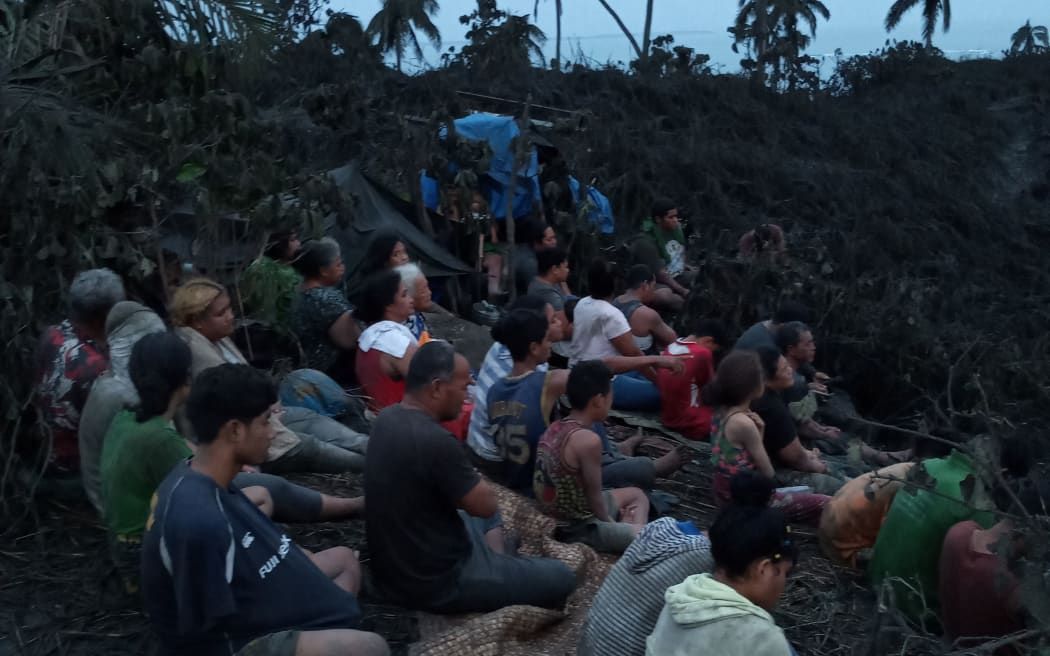
Tongan's gather at St Mary's Cathedral in Nuku'alofa to commemorate the one year anniversary of the eruption and tsunami. Photo: RNZ / Angus Dreaver
Monday 15 January marks two years since the eruption of the Hunga Tonga-Hunga Ha'apai volcano, which devastated areas of the Kingdom.

This handout photo taken on January 16, 2022 and received on January 25 courtesy of Reverend Kisini Toetu'u via Matangi Tonga shows survivors praying on a hilltop at dawn on Mango Island, following the January 15 eruption of the nearby Hunga Tonga-Hunga Ha'apai underwater volcano. Photo: AFP PHOTO / Courtesy of Rev. Kisini Toetu'u via Matangi Tonga" -
Tsunami waves generated by the eruption killed three people and resulted in damage to thousands of homes and infrastructure.
Volcanic ash, launched high into the atmosphere during the eruption, covered large areas and contaminated water supplies.
Two years on, some people evacuated from the island of Nomuka are still awaiting housing. However, at a press conference on Friday 12 January, Prime Minister Hu'akavameiliku said the housing was almost completed.
Eruption impacts Tongan tourism almost as much as Covid-19
A tourism crisis impacts assessment report revealed that one-third of tourism accommodation operators and restaurants in Tonga were severely damaged or destroyed by the eruption.
Some of the most popular and vibrant tourist resorts were also destroyed, including: Liku'alofa Beach Resort, Hatafu Beach Resort, Pangaimotu Resort, White Sands Beach Resort, and Blue Banana Beach Houses.
The retail industry, which is also heavily dependent on tourism, was impacted by both the eruption, on 15 January 2022, and the Covid lockdown in early February 2022.
"The Covid was worse … the Covid, that was the one that hurt us the most," Toni Molitika, owner of a retail store in the Nuku'alofa suburb of Kolomotu'ua, said.
"We had to close … it hurt us, Covid hurt us more than the tsunami," he added.
Tongan volcano eruption effects surprise scientists around the world

Underwater research at Hunga Tonga-Hunga Ha'apai. Photo: Supplied / Patrick Smallhorn-West
The Hunga Tonga-Hunga Ha'apai volcano erupted with the power of a 65-megaton explosion, nearly three times as powerful as the most destructive nuclear weapon ever built. Despite its cataclysmic effects the eruption has fascinated scientists.
A NIWA study found the eruption triggered the fastest underwater debris flow ever recorded - at 122 kilometres per hour. The underwater debris flow was powerful enough to rip apart undersea telecommunication cables 80 kilometres away.
"It threw cubic kilometres of material into the upper atmosphere," NIWA marine geologist Kevin Mackay told RNZ.
Scientists all over the world measured disturbances in their local areas during the eruption and earthquake stations around the globe registered tremors.

NIWA research vessel RV Tangaroa is heading to Tonga to assess the undersea impacts of the Hunga-Tonga Hunga-Ha'apai volcano eruption in early 2022. Photo: NIWA / Dave Allen
In the Canary Islands, scientists from University College London (UCL), were surprised when they detected pressure changes in the East Atlantic caused by sounds generated by the eruption.
"It must have been a long wavelength feature because we see it best at the deepest seismometers on the abyssal plain, less well in shallower waters," UCL's Dr Stephen Hicks told BBC News.
The eruption even affected space, surprising astronomers. NASA revealed that shockwaves from the explosion triggered winds up to 724km/h that were measured by satellites at altitudes of up to 193km, above Karman Line - the official edge of space,
"The volcano created one of the largest disturbances in space we've seen in the modern era," University of California physicist Brian Harding said in a media statement.
Harding, who co-authored a NASA report that investigated the effects of the volcano, said they were startled by what they saw.
"I don't think any of us expected to see anything this large," Harding said.
"We expected the disturbances to be small, like little ripples that went into the ionosphere."
The Hunga Tonga-Hunga Ha'apai eruption is the largest since the 1883 eruption of Krakatoa in Indonesia, and the largest ever recorded by modern instrumentation.
Satellites from space captured the moment of the blast, when tonnes of ash and 144 billion litres of water (enough to fill 58,000 Olympic swimming pools) were shot into the atmosphere.
"This massive local enhancement of water caused substantial impacts on atmospheric chemistry, increased ozone loss, both due to gas-phase chemistry and in association with the enhanced volcanic aerosol," NIWA principal scientist Atmosphere and Climate Olaf Morengstern said.
"As a result, some highly unusual ozone depletion happened in the tropics in the aftermath of the eruption."


